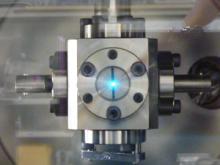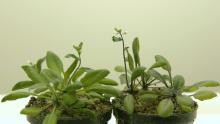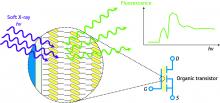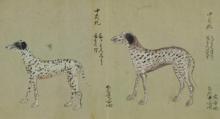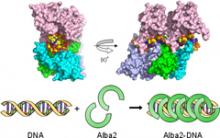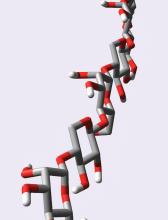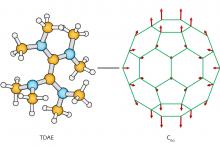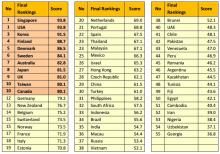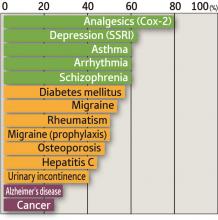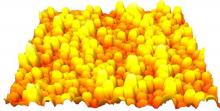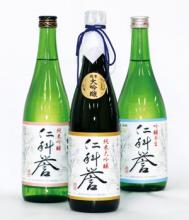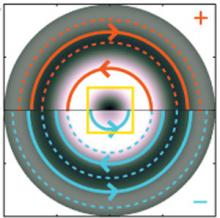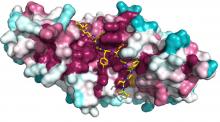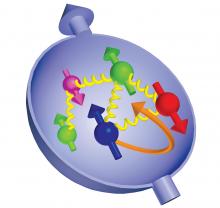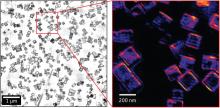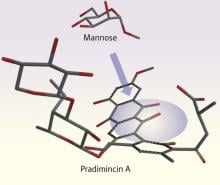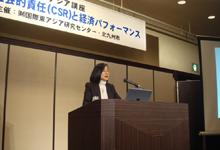Japan
News
09 Mar 2012
Biologists are uncovering intricate pathways underlying the chemical modification of a functionally important class of plant molecules
09 Mar 2012
Fluorescence-yield x-ray spectroscopy provides a view into how organic transistors work at the molecular scale
08 Mar 2012
Masayuki Manabe from Waseda University in Japan discusses the changing relationship between humans and animals.
07 Mar 2012
Researchers at the RIKEN SPring-8 Center in Japan have clarified for the first time how chromatin in archaea, one of the three evolutionary branches of organisms in nature, binds to DNA. The results offer valuable clues into the evolution of chromatin structure and promise insights into how abnormalities contribute to cancers and gene disorders.

02 Mar 2012
On February 14, the Venture Business Laboratory (VBL) at Toyohashi University of Technology hosted the 8th Toyohashi tech Industry-Government-Academia Interchange Forum 2012, featuring "the next generation integrated optic devices - Optoelectronic Integration/Nano-photonics area".
02 Mar 2012
Imaging data suggest that conscious perception has little to do with the primary visual cortex—the region where visual information enters the brain
02 Mar 2012
An Alaskan beetle beats the cold using an unusual, natural antifreeze with a novel mode of action that scientists are beginning to unravel
02 Mar 2012
A theoretical model for the unusual occurrence of magnetism in organic molecules may help develop this class of material for electronics applications.

28 Feb 2012
Takashi Hamano from Waseda University explores the issues surrounding humans and animals.
24 Feb 2012
Waseda University Institute of e-Government is pleased to release the 2012 Waseda University International e-Government Ranking. This is the eighth consecutive year of monitoring the development of e-Government worldwide by the research team of Prof. Dr.Toshio Obi, Director of Institute of e-Government.

24 Feb 2012
Researchers at the RIKEN-MIT Center for Neural Circuit Genetics have discovered an answer to the long-standing mystery of how brain cells can both remember new memories while also maintaining older ones.
24 Feb 2012
The RIKEN Center for Genomic Medicine is examining how drugs can be matched to a patient’s genetic information through the study of single nucleotide polymorphisms. Taisei Mushiroda from the Laboratory for Pharmacogenetics explains...
24 Feb 2012
By training birds to ‘get rhythm’, scientists uncover evidence that our capacity to move in time with music may be connected with our ability to learn speech
24 Feb 2012
Development of polymer film loaded with antibodies that can capture tumor cells shows promise as a diagnostic tool

23 Feb 2012
Late last month, the 'TUT CALL' advisor, Associate Professor Takahiko Hayashi along with Toyohashi Tech's international students from Bangladesh, Brazil, Mexico, Indonesia and Korea in addition to five Japanese students visited Toyohashi City Hosoya Elementary School to have an exchange party.

20 Feb 2012
Daisuke Ishida from Waseda University, Japan, discuss the influence that information technology such as the Internet has had on consumer behavior, from the three perspectives of engaging information, searching for information and transmitting information.
17 Feb 2012
Heavy ion beams produced by the RIKEN Ring Cyclotron at the RI Beam Factory have played a key part in the alcoholic beverage-brewing process.
17 Feb 2012
A theory that accurately describes the properties of relativistic electron vortex beams will impact applications such as electron microscopy
17 Feb 2012
By piecing together the interactions between a pair of proteins involved in colorectal cancer, researchers may have identified suitable targets for drug development
17 Feb 2012
Development of a theoretical framework for interpreting the results of subatomic-particle collisions could provide insight into proton composition

14 Feb 2012
In late January 2012, Tokyo University of Science President Akira Fujishima visited Hyderabad University during a trip to India as a guest lecturer and concluded an academic exchange agreement.
14 Feb 2012
The National Institute for Materials Science in Japan has concluded a Comprehensive Collaborative Agreement (a sister institute agreement) with National Taiwan University (NTU) in Republic of China (Taiwan).
10 Feb 2012
A new method to map nanostructures within materials may lead to biological imaging of the internal organization of cells
10 Feb 2012
Revelation of how certain compounds adhere so strongly to HIV’s coat points to a fresh therapeutic approach
10 Feb 2012
Measurements from high-energy collision experiments lead to a better understanding of why meson particles disappear
09 Feb 2012
New research holds promise for applications ranging from high-precision optical components to tooth fillings.
09 Feb 2012
In response to the unprecedented disaster that Eastern Japan faced on March 11, 2011, Waseda University established a disaster response headquarters immediately after the earthquake, and worked towards determining which students, alumni and teachers were affected as well as working on other urgent needs.

08 Feb 2012
A solemn dedication ceremony was held at Waseda University on October 24 marking the 25th year since the passing of Sugihara Chiune, a former Waseda alumnus who has famously been referred to as the “Oskar Schindler of Japan.”
08 Feb 2012
Megumi Suto, a Professor at Waseda University, delves into the relationship between the economy and society.
Researchers
Sorry, no researchers coming up for this topic.
Giants in history
Ruby Sakae Hirose (1904 – 1960) was a Japanese-American scientist whose research contributed significantly to our understanding of blood clotting, allergies and cancer.
Haisako Koyama (1916 – 1997) was a Japanese solar observer whose dedication to recording sunspots – cooler parts of the sun’s surface that appear dark – produced a sunspot record of historic importance.
Michiaki Takahashi (17 February 1928 – 16 December 2013) was a Japanese virologist who developed the first chickenpox vaccine.
Toshiko Yuasa (11 December 1909 – 1 February 1980) was the first Japanese female physicist whose research on radioactivity shed light on beta decay – the process in which an atom emits a beta particle (electron) and turns into a different element.
Baron Kitasato Shibasaburo (29 January 1856 – 13 June 1931) was a Japanese physician and bacteriologist whose work led to a new understanding of preventing and treating tetanus, diphtheria and anthrax.
By isolating soil microorganisms and studying the compounds they produce, Satoshi Omura (born 1935) discovered almost 500 organic compounds with unique properties that were produced by these microorganisms, including many new antibiotics.
In 1915, pathologist Katsusaburo Yamagiwa and his research assistant Koichi Ichikawa became the first to prove that chronic exposure to chemicals can cause cancer.
In 1915, Koichi Ichikawa along with pathologist Katsusaburo Yamagiwa became the first to prove that chronic exposure to chemicals can cause cancer.
Reiji Okazaki (8 October 1930 – 1 August 1975) and Tsuneko (7 June 1933) were a Japanese couple who discovered Okazaki fragments – short sequences of DNA that are synthesized during DNA replication and linked together to form a continuous strand.
Tsuneko (7 June 1933) and Reiji Okazaki (8 October 1930 – 1 August 1975) were a Japanese couple who discovered Okazaki fragments – short sequences of DNA that are synthesized during DNA replication and linked together to form a continuous strand.
Husband and wife team, Kimishige (3 December 1925 – 6 July 2018) and Teruko Ishizaka (28 September 1926 – 4 June 2019) discovered the antibody class Immunoglobulin E (IgE) that triggers allergic reactions. They also discovered that IgE antibodies attach to white blood cells, known as mast cells, releasing histamine, which causes allergic reactions.
Husband and wife team, Kimishige (3 December 1925 – 6 July 2018) and Teruko Ishizaka (28 September 1926 – 4 June 2019) discovered the antibody class Immunoglobulin E (IgE) that triggers allergic reactions. They also discovered that IgE antibodies attach to white blood cells, known as mast cells, releasing histamine, which causes allergic reactions.
Japanese chemist Takamine Jokichi (3 November 1854 – 22 July 1922) founded the Tokyo Artificial Fertilizer Company, where he isolated a starch-digesting enzyme (named takadiastase) from the fungus Aspergillus oryzae.
Hideki Yukawa (23 January 1907 – 8 September 1981) was awarded the Nobel Prize in Physics in 1949 for predicting the existence of the pi meson subatomic particle. Japan’s first Nobel laureate, Yakawa also expressed his support for nuclear disarmament by signing the Russell–Einstein Manifesto in 1955.
Shinichiro Tomonaga (31 March 1906 – 8 July 1979), together with Richard Feynman and Julian Schwinger, was awarded the Nobel Prize in Physics in 1965, for their contributions to advance the field of quantum electrodynamics. Tomonaga was also a strong proponent of peace, who actively campaigned against the proliferation of nuclear weapons and promoted the peaceful use of nuclear energy.
Japanese chemist Kenichi Fukui (4 October 1918 – 9 January 1998) was the first Asian scientist to be awarded the Nobel Prize in Chemistry. Together with Roald Hoffman, he received this honour in 1981 for his independent research into the mechanisms of chemical reactions.
Minoru Shirota (April 23, 1899 – March 10, 1982) was a Japanese microbiologist who invented the popular fermented drink Yakult.
Japanese physicist Ukichiro Nakaya (1900-1962) made the world’s first artificial snowflakes. He started his research on snow crystals in the early 1930s at Hokkaido University, where there is an unlimited supply of natural snow in winter. By taking over 3,000 photographs, he established a classification of natural snow crystals and described their relationship with weather conditions.
The techniques that make industrial pearl culturing possible were developed over a century ago at the Misaki Marine Biological Station in Japan. The station’s first director, Professor Kakichi Mitsukuri, emphasized to Kokichi Mikimoto in 1890 that stimulating pearl sac formation was important for pearl growth, and they went on to successfully develop methods for culturing pearls.
The field of solid-state ionics originated in Europe, but Takehiko Takahashi of Nagoya University in Japan was the first to coin the term ‘solid ionics’ in 1967. ‘Solid-state ionics’ first appeared in 1971 in another of his papers, and was likely a play on ‘solid-state electronics’, another rapidly growing field at the time.
Chika Kuroda (24 March 1884 – 8 November 1968) was a Japanese chemist whose research focussed on the structures of natural pigments.
Motoo Kimura (13 November 1924 – 13 November 1994) was a Japanese theoretical population geneticist who is best remembered for developing the neutral theory of molecular evolution.
Osamu Shimomura (27 August 1928 – 19 October 2018) was a Japanese organic chemist and marine biologist who dedicated his career to understanding how organisms emitted light.
Kikunae Ikeda (8 October 1864 – 3 May 1936) was a Japanese chemist who discovered the fifth basic taste, umami.
Umetaro Suzuki (7 April 1874 – 20 September 1943) was a Japanese scientist best remembered for his research on beriberi, a disease caused by vitamin B1 deficiency, characterized by limb stiffness, paralysis and pain.
Kono Yasui (16 February 1880 – 24 March 1971) was a Japanese botanist who researched the genetics of poppies, corn and spiderworts and surveyed the plants that had been affected by the nuclear fallout after the atomic bombings of Hiroshima and Nagasaki.
Hitoshi Kihara (1893 – 1986) was one of the most famous Japanese geneticists of the 20th century. One of his most significant contributions was identifying sex chromosomes (X and Y) in flowering plants.
Michiyo Tsujimura (17 September 1888 – 1 June 1969) was a Japanese agricultural scientist and biochemist recognized for her research of green tea components.
A Japanese surgeon, Tetsuzo Akutsu (20 August 1922 – 9 August 2007) built the first artificial heart capable of keeping an animal alive.
Ogino Ginko (3 March 1851 – 23 June 1913) was the first registered female doctor to practise modern medicine in Japan.
Japanese geochemist Katsuko Saruhashi developed the first method and tools for measuring carbon dioxide in seawater


